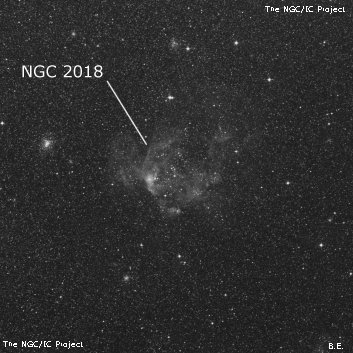
The brightest region of nebulosity (N206A) is a very prominent 1' circular patch on the east end of the cluster. Fainter wings extend north and south, increasing the size to 3'x1' N-S. A wide pair of stars including mag 11.5 HDE 269676 [a massive, compact cluster containing several O-type stars] is at the west edge of this patch. Three additional elongated patches (each 1' to 1.5' in diameter) along the SW side of the complex are strung out in a 6' line oriented NW to SE; BSDL 2005 (7' W of NGC 2018), BSDL 2048 (5' WSW) and N206B = BSDL 2120 (5' SW). Another glowing patch of nebulosity (BSDL 2108), ~45" diameter, is ~3' W of N206A and surrounds a couple of brighter stars. Finally, an isolated, elongated patch is on the northwest end of the complex (BSDL 1985, associated with mag 13.0 HD 37248, a WC4+O9 Wolf-Rayet binary) that seems detached. Weaker sections of the nebulosity give the impression of dark lanes. The entire complex forms a superbubble extending ~12' E-W and ~9' N-S. Surprisingly, Herschel's description applies only to the brightest region at the east end of this entire complex.
John Herschel discovered NGC 2018 = h2904 on 3 Nov 1834 and recorded "pB; R; pglbM; 2'; a star 10m involved, preceding." His position (single sweep) is on the southeast side of the brightest portion of the nebula. The ESO position is centered on the entire complex described in my notes and not the bright piece described by Herschel.
600/800mm - 24" (4/5/08 - Magellan Observatory, Australia): this is a fascinating, showpiece HII complex (N206) with a cluster (S-L 533) and a large, detailed nebula (N206) appearing like a fainter version of M8 -- of course, in another galaxy! At 200x the cluster is ~8' in diameter and includes a couple of dozen mag 11-15 stars (part of the stellar association LH 69). The stars are involved in the glow of a bright HII complex (LMC-N206) that has an excellent response to a UHC filter.
Notes by Steve Gottlieb